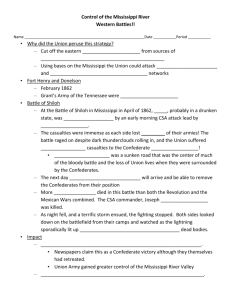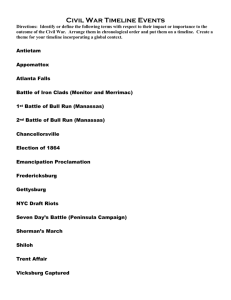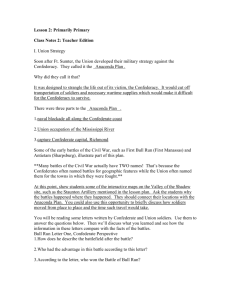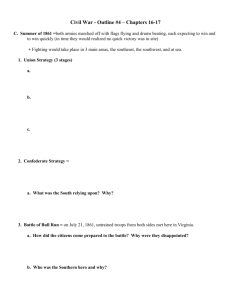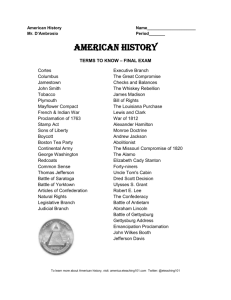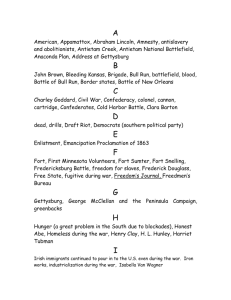Early Years of the War
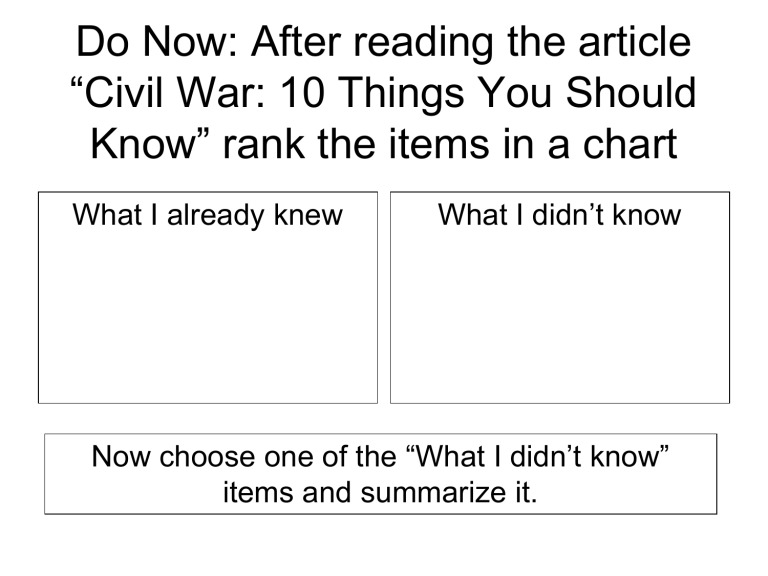
Do Now: After reading the article
“Civil War: 10 Things You Should
Know” rank the items in a chart
What I already knew What I didn’t know
Now choose one of the “What I didn’t know” items and summarize it.
Early Years of the War chart - notes
Early Years of the War
We will learn…
• what successes and failures the North and the South had in the early years of the Civil War.
• how the North’s naval blockade hurt the
South
• how the battle of Antietam turned the tide of the war.
Click the mouse button or press the Space Bar to display the information. Additional lecture notes appear on the following slides.
Civil War cannon
Click the Speaker button to replay the audio.
Section 2-4
Bull Run
Location:
Manassas, Virginia - near a river called Bull
Run
Dates:
July 21, 1861
Bull Run
Events:
• 30,000 inexperienced Union troops commanded by Gen.
Irvin McDowel attacked confederate troops led by
P.G.T. Beauregard.
• Yankees drove
Confederates back at first.
• Rebels rallied under Gen.
Thomas Jackson – became known as “Stonewall
Jackson”.
Bull Run
Outcome:
• Confederates unleashed a counter attack and surged forward with a “rebel yell”.
• Terrified Union troops retreated. Confederates were victorious but did not pursue.
Click the mouse button or press the Space Bar to display the information.
Bull Run
Effects:
• Northerners began to understand that the war could be a long, difficult, and costly struggle.
• President Abraham Lincoln requested 1 million soldiers who would serve for 3 years.
• Lincoln appointed a new general, George B.
McClellan , to head the Union army of the East – called the Army of the Potomac –and organize the troops.
Click the mouse button or press the Space Bar to display the information.
Battle of Bull Run
Monitor vs. Merrimack
Location:
Norfolk, Virginia
Chesapeake Bay
Date:
March 9, 1862
Monitor vs. Merrimack
Events:
• Confederates had salvages a Union warship
( Merrimack ), rebuilt it, outfitted it in iron and renamed it the Virginia
• North had an iron clad ship, Monitor
• On March 9, the two ironclads exchanged fire, but neither ship could sink the other.
Monitor vs. Merrimack
Outcome:
• The Union succeeded in keeping the Merrimack in the harbor, so it never again threatened
Northern ships.
Effects:
• South is not able to break Northern blockade
Lincoln’s Plan
War at Sea
Shiloh
Location:
Shiloh, Tennessee (near important railroad junction along Tennessee
River)
Date:
April 6-7, 1862
Shiloh
Events:
• Confederate forces led by Albert Sidney
Johnston and P.G.T. Beauregard launched a surprise attack on the Union troops.
• On the first day of battle, the Confederates drove
Grant and his troops back to the Tennessee
River.
• On the second day, the Union forces recovered and defeated the Confederates, who withdrew to
Corinth.
• Grant becomes known as “Unconditional
Surrender” Grant
April 6 – first day of battle at Shiloh. The Confederates pushed the Union center to the “sunken road”. This became known as the “hornets nest” as the
Confederates unleashed a volley of fire so fierce that the bullets were like hornets whizzing by their ears.
Shiloh
Outcome:
• Together the two armies suffered
20,000 casualties –people killed or wounded – including Confederate general Johnston who died in the bloodbath.
Effect:
• Union forces gained control of Corinth on May 30, and, on June 6, Memphis,
Tennessee, fell to Union armies.
The War in the West
Battle of Shiloh
•
•
DO NOW: Describe the success and failures of the North in the early years of the war:
•
Northern Successes
•
Northern Failures
•
•
Northern Successes
• Shiloh
Northern Failures
• Fort Sumter
• New Orleans
• Antietam
• Bull Run
• 7 Days Battle
(Monitor vs. Merrimack) • 2 nd Battle of Bull Run
New Orleans
Location:
New Orleans, Louisiana
Date:
April 25,1862
New Orleans
Events:
• Union naval forces under David Farragut captured New Orleans , Louisiana, the largest city in the South.
New Orleans
Outcome:
• Union capture of New Orleans, near the mouth of the Mississippi River, meant that the Confederacy could no longer use the river to carry its crops to sea.
Effects:
• Farragut’s capture of New Orleans gave Union forces control of almost all the Mississippi River.
Seven Days Battle
Location:
Richmond, Virginia – near James River
Date:
June 1862
Seven Days Battle
Events:
• McClellan moved his huge army by ship to a peninsula between the York and the James Rivers southeast of the city.
• From there he began a major offensive known as the
Peninsula Campaign .
• McClellan’s delays allowed the Confederates to prepare
Richmond’s defense.
• At the end of June, the Union forces finally met the
Confederates in a series of encounters known as the
Seven Days battles
• Confederate commander James E.B. ( J.E.B.
) Stuart , led his 1,200 troops in a circle around the Union army, gathering vital information about Union positions and boosting Southern morale
Seven Days Battle
Outcome:
• General Lee boldly countered Union advances and eventually drove the
Yankees back to the James River.
Effects:
• The North failed to capture Confederate capital of
Richmond & South’s morale was boosted
War in the East
Seven Days Battle
Antietam
Location:
Sharpsburg, Maryland
Date:
September 17, 1862
Antietam
Events:
• Confederate president Jefferson Davis ordered Lee to launch an offensive into Maryland northwest of
Washington.
• As Lee’s army marched into Maryland in September
1862, McClellan and 80,000 Union troops moved slowly after them.
• Lee gathered most of his forces together near
Sharpsburg, Maryland, along the Antietam Creek.
• The Union and the Confederate armies clashed on
September 17 in the Battle of Antietam –the single bloodiest day of the entire war.
Antietam
Outcome:
• Confederate forces held the Union out of
Sharpsburg, but Lee decided not to stay and occupy the town after having received no aid from the slave holding area.
• Resulted in 23,000 casualties.
Bloody Lane
Effects: Hagerstown Road
• Lee withdrew to Virginia, allowing the Union troops to claim victory.
• McClellan did not pursue the Confederate troops,
Lincoln replaced him with Gen. Ambrose
Burnsides
• Gives Lincoln the victory he wanted to issue the
Emancipation Proclamation
Review
Create a flow chart to show the main sequence of events in the Battle of
Antietam
McClellan is replaced by Gen.
Burnsides
With your partner:
• Take a look at p. 492-493 in your book
• Read over the descriptions and look at the map of Antietam
• Answer the two “Learning from
Geography” questions
With your partner:
• Write a letter home from the perspective of a soldier who just fought in the Battle of
Shiloh
DO NOW:
READ the story on p. 465 and answer the two “Analyzing Literature” questions.
Also answer:
• What was the setting?
• Who was the main character?
• What was the plot?
The Battle of Antietam
(cont.)
• The president, disgusted with McClellan’s failure to follow up his victory, removed
McClellan from his command.
• Lincoln placed General Ambrose
Burnside in command of the Army of the
Potomac.
• The Army of the Potomac finally gained some confidence, having forced Lee and his soldiers back south.
• President Lincoln used the Battle of
Antietam to take action against slavery.
Click the mouse button or press the Space Bar to display the information.
With your partner:
• Write a newspaper headline to describe the events of the Monitor vs. Merrimack battle
• Draw a picture to illustrate the battle
Study Guide
On Study Guide, you should be able to answer:
Bull Run
Hampton Roads (
Monitor vs.
Merrimack)
Thomas “Stonewall” Jackson
Questions #1, 2, 3, 4, 6


